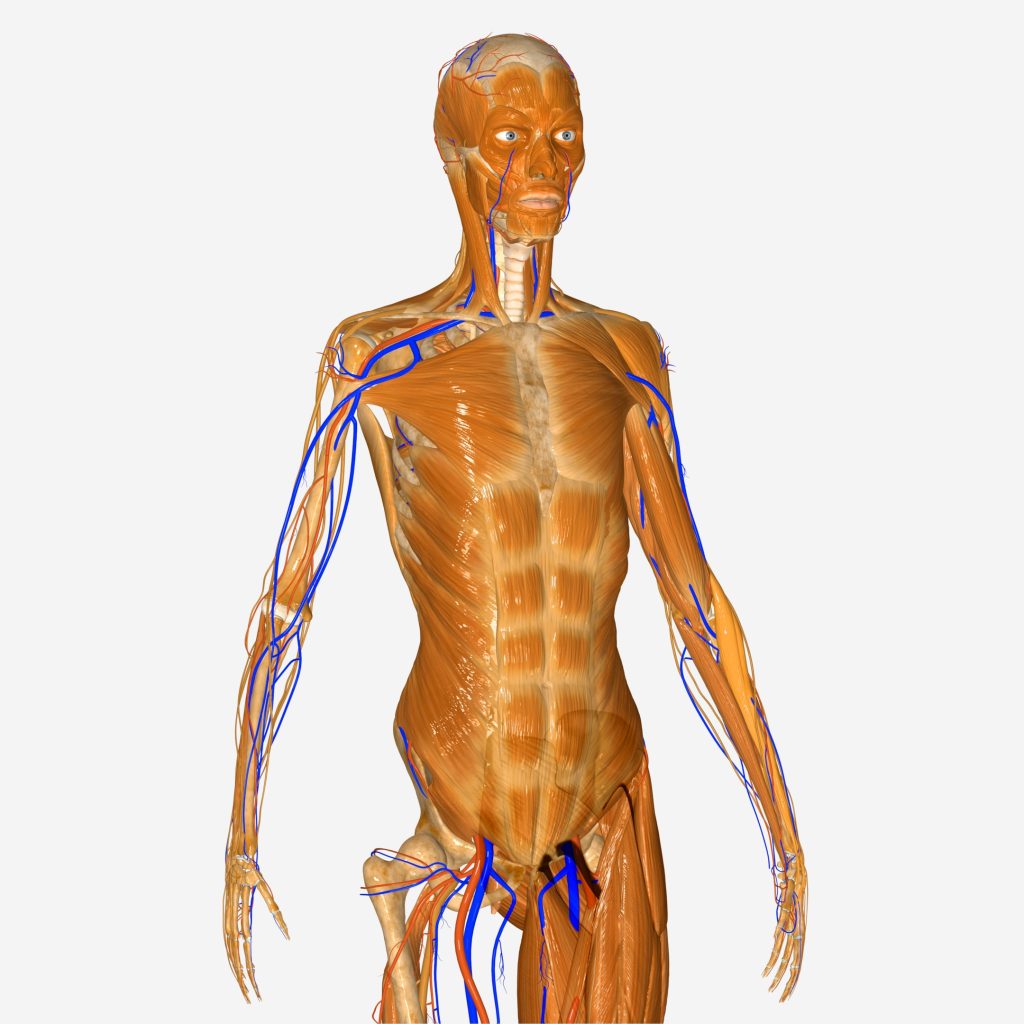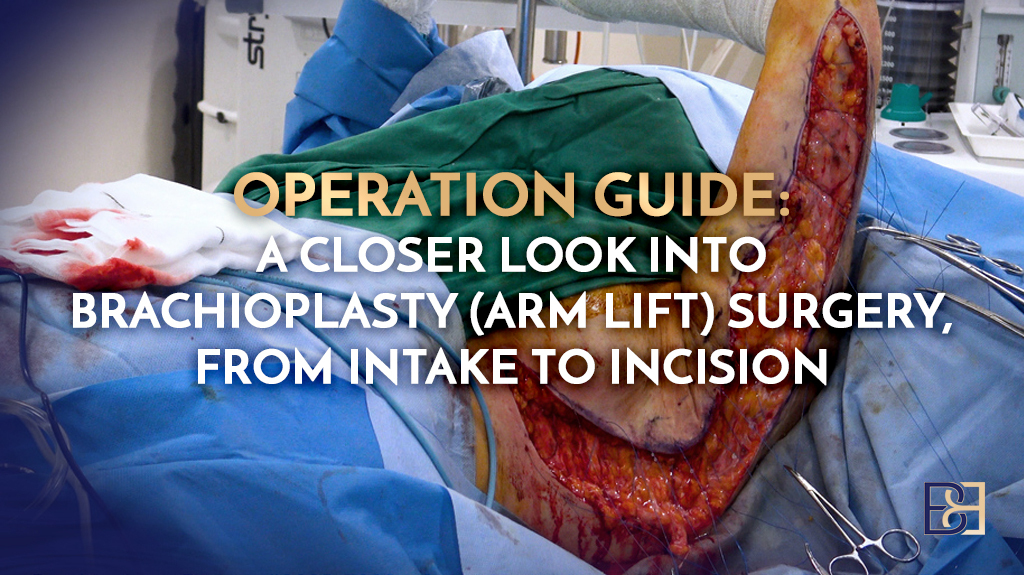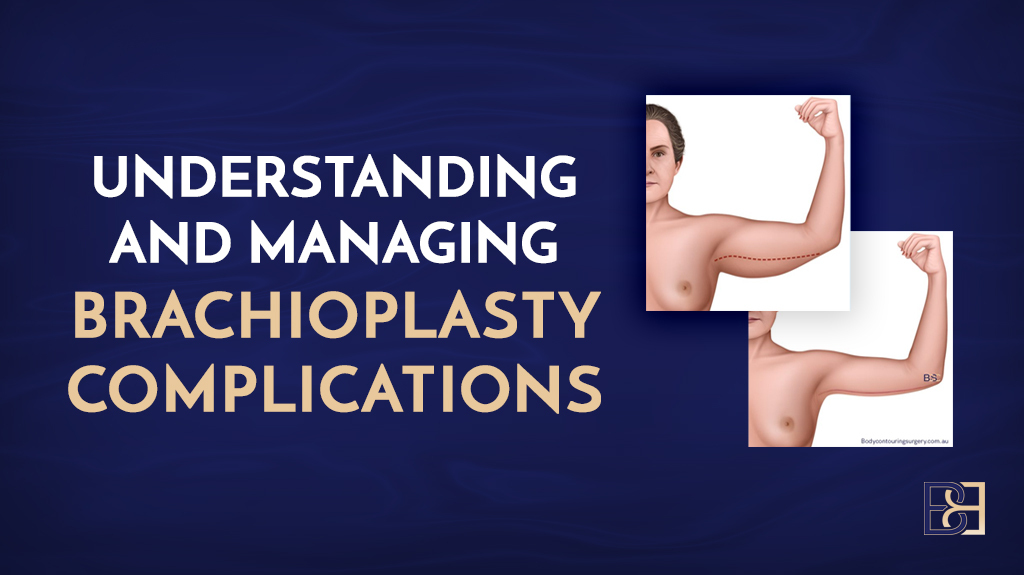Nerve injury is a recognised complication of almost any surgery. There is a wide spectrum of nerve injuries, from mild lesions that recover spontaneously to the most severe, in which intervention is required. For a surgeon, the challenge rests in identifying the extent of the injury, as prompt recognition and action will ensure the disability from the nerve injury is kept to the minimum.
Book your appointment online now
Traumatic Nerve Damage Following Brachioplasty Surgery
As your FRACS surgeon, it is my responsibility to discuss potential risks and complications for my patients considering brachioplasty surgery. Though nerve injuries are rare during a Brachioplasty procedure, one severe potential risk is traumatic nerve damage.
Major Nerves in the Arm

In the arm, there are groups of nerves that send signals from the spinal cord to the hand, arm, and shoulder called brachial plexus. This group of nerves is responsible; for the sensations and reflexes felt during shoulder and arm movement. Brachial plexus injuries during brachioplasty can affect the following nerves:

Ulnar Nerve
The ulnar nerve is one of five nerve branches of the brachial plexus. The job of this bundle of nerves is to send sensory information to allow for shoulder, arm, and hand movement.
Starting at the collarbone (clavicle), the brachial plexus extends through the armpit (axilla) and down the arm.
Radial Nerve
Radial nerves are present in each arm. These nerves control sensory and movement functions in the posterior section of your upper limb from the central nervous system.
Axillary Nerve
The axillary nerve runs through the quadrangular space, starting at the ramus of the C6 and C5 spinal nerves and going through to the brachial plexus’s posterior cord.
Median Nerve
Median sensory nerves supply sensory and movement functions to the hand, wrist, and forearm. They are also responsible for transmitting pain, touch, and temperature sensations to the brain and spinal cord.
Musculocutaneous Nerve
The musculocutaneous nerve originates from the lateral cord of the brachial plexus and includes fibres from cervical spinal nerves C5 through C7. As it descends within the anterior compartment of the arm, the nerve supplies three compartment muscles: the biceps brachii, coracobrachialis, and brachialis. When the musculocutaneous nerve passes laterally to the tendon of the biceps brachii, it changes its name to the lateral antebrachial cutaneous nerve, also known as lateral cutaneous nerve of the forearm. This nerve is responsible for motor control in the anterior arm and sensory feedback from the lateral forearm.
Nerve damage following brachioplasty surgery can happen when these nerves are compressed, stretched, or torn apart.
Arm Nerve Injuries After Brachioplasty Surgery
Brachial plexus injuries during Brachioplasty Surgery occur when the nerves become squeezed, stretched, and, in serious situations, ripped apart.
Some of these injuries include;
- Medial brachial cutaneous injury: This type of brachial plexus injury affects five in 100 patients. It is characterised by a burning, tingling, or pain sensation in the affected arm (similar symptoms to carpal tunnel syndrome). Severe medial brachial cutaneous injuries can result in chronic inflammatory demyelinating polyneuropathy, (CIDP) a rare neurological condition that causes progressive muscle weakness, and numbness.
- Neuroma: A condition where nerve tissue gets trapped in scar tissue after a brachioplasty procedure. Patients who experience neuroma complain of severe pain in the affected region.
- Compressed ulnar nerve, radial nerve, and median nerve: This condition results from the ulnar, radial, and median nerve becoming compressed due to excessive swelling post-op.
- Chronic nerve damage: Chronic nerve damage, an extremely rare condition that occurs when the affected nerves become stretched and squeezed to the point that they become damaged, can be quite painful. Other signs of nerve damage include restricted movement, sensation changes, paralysis, pain, and swelling.
Clinical Signs Suggesting a Nerve is in Danger
Once the effects of general/regional anaesthesia has worn off, the following clinical symptoms/signs may imply that a nerve has been significantly damaged:
- Unrelenting pain: This is the type of sharp, severe, burning pain that does not dissipate even with prescription pain medications.
- Loss of movement and sensation: This may be anything from a loss of sensation to a complete loss of functionality.
- Positive Tinel’s Sign (Hoffman-Tinel Sign): This is a diagnostic tool used by healthcare providers to detect irritation or nerve damage at a specific location. When the provider gently taps the skin over a nerve, you may experience a tingling sensation or a “pins and needles” feeling. This response can indicate nerve compression or damage at the site of tapping.
- Excessive sweating

Possible Ramifications of Nerve Injuries
An injured nerve may lead to:
- Numbness or tingling
- Neuropathic pain that ranges from mild to severe
- Burning sensations
- Edema
- Motor impairment that may result from loss of nerve function
- Muscle weakness
- Immune system attacks on nerve tissues, which could lead to complications such as Chronic Inflammatory Demyelinating Polyneuropathy (CIDP)
- Compartment syndrome (tenderness, swelling, and pink skin)
Neuropathic Pain, Numbness, And Tingling After Brachioplasty Surgery
During our initial consultative session, I will advise you about the signs to look out for and which require immediate attention following brachioplasty surgery. Though experiencing pain, firmness, swelling, and tenderness is normal immediately following brachioplasty surgery, these symptoms should decrease in severity as you continue healing. Therefore, if you experience any of these conditions after your brachioplasty, there is normally no need to panic.
However, if you notice an unusual trend, such as the swelling or numbness becoming more pronounced, or pain worsening and not subsiding with pain medicine, I urge you to notify me right away.
Traumatic Nerve Injury to Brachial Plexus Nerves
Traumatic nerve injury to the brachial plexus nerves can be painful. In addition to pain, common signs of a traction injury are partial or total loss of sensation.
After surgery, I advise my patients to stay vigilant and promptly alert us if they notice any unusual, worsening, or severe symptoms that could indicate complications such as peripheral neuropathy. Early diagnosis and treatment can lead to better outcomes. If any issues are identified after surgery, you will be referred to a neurologist for further assessment and testing.

Diagnostic Tests for Nerve Damage
Once you’ve notified us of the signs of peripheral nerve damage, a neurologist will conduct a visual and physical exam to confirm whether you have nerve damage and the extent. Common imaging tests and diagnostic tools include;
Nerve Conduction Studies (NVC)
The NVC test measures nerve function by determining how fast electrical impulses move through your nerves. A neurologist places electrodes on the affected area to stimulate the nerve, initiating the transfer of impulses. Any unusual patterns or abnormalities recorded indicate potential nerve damage.
Electromyogram Studies (EMG)
The Electromyogram test (EMG) measures the electrical activity within your muscles as they expand and contract. A neurologist will assess how the motor neurons facilitate arm and hand movement to communicate with the affected muscle. Any signs of immobility or weakness will indicate potential nerve damage.
High-resolution Ultrasound
If your condition is severe and it’s clear you’re experiencing traumatic nerve damage, a high-resolution imaging scan will accurately map out the affected site. Further analysis of these scans can help a neurologist identify the nerve and the extent of the damage.
Exploratory surgery
Exploratory surgery is the final option for diagnostic testing. It is typically performed by a neurosurgeon and involves surgery to locate compressed or injured nerves. This procedure is invasive and carries higher risks compared to the aforementioned procedures.
Treatment Options for Nerve Damage After Brachioplasty Surgery
After confirming you are suffering from traumatic nerve damage, your ideal treatment option will depend on the type of nerve damage and its extent. Note that numbness and tingling (mild paraesthesia) around the affected region may subdue and resolve on their own; however, not always.
There are different peripheral neuropathy treatments available. Peripheral neuropathy refers to a disease or damage affecting the peripheral nerves (nerves located outside the brain and spinal cord). Such damage results in peripheral neuropathy symptoms that impair sensation, glad function, movement, or organ function.
Nerve Damage Neuropathy Treatments
Nerve Blocks
Nerve blocks or neural blockades remedy the severe pain caused by nerve damage. Ideal for mild cases, this treatment option offers up to 18 hours of pain relief by blocking pain signals from the damaged nerves.
Steroid Injections
The goal of these injections is to increase the rate at which the damaged or injured nerves heal. They also offer pain relief for the peripheral neuropathy pain caused by traumatic nerve damage. Steroid injections are also ideal for less severe damage.
Medications
Several over-the-counter medications can help relieve the more mild cases of neuropathic pain. Your GP may also prescribe prescription medications that target nerve pain. The relief manages the pain, allowing the injured nerves to recuperate.
Surgical Release of the Skin Incision
In cases of severe nerve damage, such as compression injuries, immediate intervention is necessary. You will need to see a neurosurgeon, who will make an incision in the affected area to treat the issue and provide relief.
After making the skin incision, the surgeon will gain access to the stretched or injured nerves and carefully decompress them, correcting the damage caused by the Brachioplasty Surgery.
Nerve Repair Surgery
Before performing the nerve decompression mentioned earlier, the neurosurgeon will assess the condition of the affected nerve to determine if there is idiopathic peripheral neuropathy. If a nerve section is severely damaged, the surgeon will carefully remove the damaged part and reconnect the remaining segment with the other nerve end. If the damaged section is too short for direct reattachment, a nerve graft may be used, where a piece of nerve from another part of the body bridges the gap between the nerves.
Nerve Grafting Surgery
Nerve grafting surgery involves replacing the nerve removed during nerve repair surgery. This nerve implant procedure involves taking a healthy nerve and grafting it in the gap left by the damaged nerve. The replacement nerve can be extracted from your body or a cadaver through nerve allografting.
Physical Therapy
Physical therapy will help you regain strength, motor function, and coordination after nerve injury.
Shockwave Therapy
Shockwave therapy facilitates nerve healing and reduces nerve inflammation. It is a non-surgical procedure that utilises high-energy sonic pulses to promote axon regeneration. This therapy involves subjecting the affected area to the sonic pulses to promote nerve healing.
Healthy Lifestyle Adjustments
Though a balanced diet, avoidance of toxic chemicals and too much alcohol use, and exercising regularly won’t cure nerve damage, certain lifestyle adjustments can help mitigate symptoms.

Avoiding Nerve Damage During Brachioplasty Surgery
Nerve injuries can happen during any surgery. Once I make an incision in your skin, the surrounding nerves are affected. Normally, these nerves regenerate after the procedure and take a few months to heal. However, traumatic nerve damage occurs when the procedure injures any major nerve located in the arm.
Medial brachial nerve damage is the most common nerve injury after Brachioplasty Surgery. I will reduce risks by placing the brachioplasty incision away from any major arm nerve by making the incision on the back side rather than the inner side.
If you’re concerned about the visibility of your Brachioplasty Surgery scar, I’ll share some remedies with you during our consultative session. Furthermore, I have performed body contouring surgery for over 15 years and have the experience to strategically place your arm lift away from any major nerves while minimising scar visibility. I have extensive knowledge of the human forearm anatomy and all surrounding nerves.
Book your appointment online now
How can I check if my nerves are okay?
You should contact me if you notice any unusual symptoms, such as pronounced swelling, numbness, or unrelenting sharp pain. I advise against conducting self-diagnosis since it is challenging to determine the extent. A FRACS surgeon with knowledge of the upper arm’s anatomy is best poised to perform visual, surgical, or non-surgical tests to determine the best treatment approach.

Dr. Beldholm’s Final Thoughts
Brachioplasty is ideal for skin laxity and arm fat after weight loss.
Mainly, the cause of traumatic nerve damage during arm lift (Brachioplasty) surgery (or any surgery) is a surgical error that occurs when a surgeon interferes with a healthy nerve.
However, permanent nerve injury is very rare after Brachioplasty Surgery. By strategically placing the brachioplasty incision away from any major arm nerves, it greatly reduces the risk of serious nerve injuries.
When you come in for a consultation, I will guide you through the entire procedure, from pre-op to to recovery. I will also highly advise that you stick to the post-op guide I’ll provide. If you identify any warning signs, don’t hesitate to contact me.
References
- Chowdhry, Saeed. “Avoiding the Medial Brachial Cutaneous Nerve in Brachioplasty: An Anatomical Study.”PubMed Central (PMC), 2010.
- High-resolution Ultrasound as an Aid in the Diagnosis and Treatment of Post-brachioplasty Injury to the Medial Brachial and the Medial Antebrachial Nerves – Two Case Reports.” International Journal of Surgery Case Reports, vol. 72, Elsevier BV, Jan. 2020, pp. 520–23.
- Hausner, T., and Antal Nógrádi. “The Use of Shock Waves in Peripheral Nerve Regeneration.” International Review of Neurobiology, 2013, pp. 85–98.
- Knoetgen, James, and Steven L. Moran. “Long-Term Outcomes and Complications Associated With Brachioplasty: A Retrospective Review and Cadaveric Study.” Plastic and Reconstructive Surgery, vol. 117, no. 7, Lippincott Williams and Wilkins, June 2006, pp. 2219–23.
- “Nerve Graft (Nerve Transplant Surgery).” Johns Hopkins Medicine, 12 Dec. 2022.
- Al-Qattan, Mohammad M. “Multiple (Median, Ulnar, Radial and Medial Antebrachial) Nerve Injury Associated With Brachioplasty.” Journal of Hand and Microsurgery, vol. 12, no. S 01, Georg Thieme Verlag, Aug. 2020, pp. S78–80.
- Sevy, J. O., Sina, R. E., & Varacallo, M. (2023). Carpal Tunnel Syndrome.
- Nisi, G., Giardino, F. R., Giudice, M., Fasano, G., Cuomo, R., & Grimaldi, L. (2022). The Jaws Brachioplasty: An Original Technique: Improving Aesthetic Outcomes in Arm Lift Procedures. Journal of clinical medicine, 11(17), 5038.
- Di Pietro, V., Colicchia, G. M., Cervelli, V., & Gentile, P. (2018). Arm Contouring After Massive Weight Loss: Liposuction-Assisted Brachioplasty Versus Standard Technique. Journal of cutaneous and aesthetic surgery, 11(2), 73–78.
- Han, H. H., Lee, M. C., Kim, S. H., Lee, J. H., Ahn, S. T., & Rhie, J. W. (2014). Upper arm contouring with brachioplasty after massive weight loss. Archives of plastic surgery, 41(3), 271–276.
- Hurwitz D. (2014). Brachioplasty. Clinics in plastic surgery, 41(4), 745–751.
- Pascal, J. F., & Le Louarn, C. (2005). Brachioplasty. Aesthetic plastic surgery, 29(5), 423–430.



